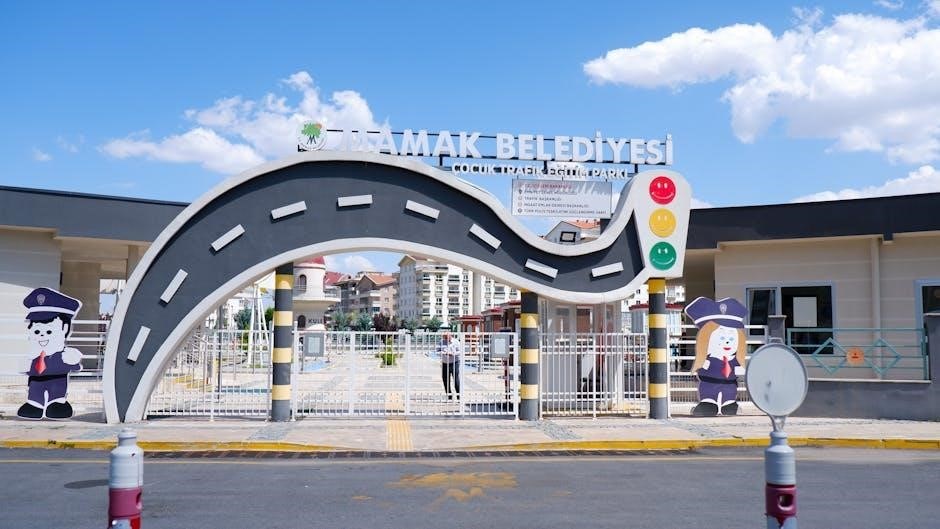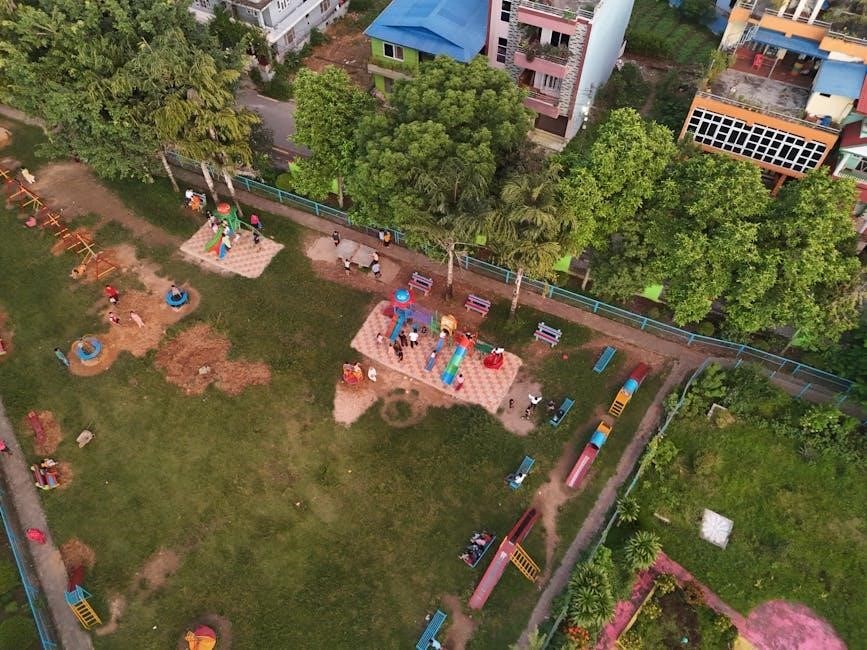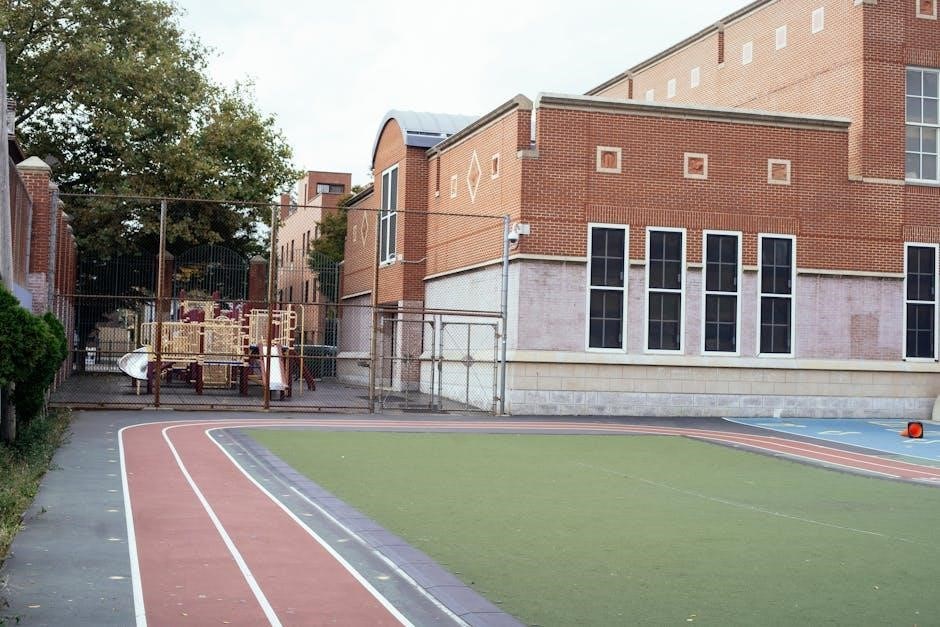Playground PDFs are valuable resources designed for children and caregivers, offering insights into play experiences, safety, and development; They provide accessible, downloadable guides for fostering creative play and learning.
1.1 Definition and Overview
Playground PDFs are digital resources that provide comprehensive guides, designs, and activities for creating engaging outdoor spaces for children. These documents often include detailed plans, safety guidelines, and educational content to enhance play experiences. They serve as valuable tools for parents, educators, and designers, offering insights into how to foster creativity, physical activity, and social interaction. Playground PDFs also highlight the importance of inclusive design, ensuring accessibility for all users. With the rise of digital accessibility, these resources are increasingly popular, offering downloadable and shareable formats for ease of use. They are designed to inspire the creation of vibrant, functional, and safe playgrounds that cater to diverse needs and preferences;
1.2 Brief History of Playground PDFs
Playground PDFs have evolved as digital resources, offering accessible guides for designing and utilizing playgrounds. Historically, playground designs were shared through physical books, but the rise of digital platforms transformed this. The shift to PDF formats allowed for widespread sharing, making playground plans and educational content more accessible. Key authors like Aron Beauregard popularized this format, creating engaging resources for caregivers and educators. These documents often blend traditional play concepts with modern safety standards, reflecting a growing emphasis on inclusive and safe outdoor spaces. Over time, Playground PDFs have become essential tools for fostering creativity, physical activity, and social learning in children, adapting to technological advancements and changing educational priorities.
Benefits of Playground PDFs
Playground PDFs offer convenient, accessible resources for enhancing play experiences, promoting learning, and fostering creativity in children through structured and imaginative activities.

2.1 Physical Development Through Play
Playground PDFs emphasize the role of play in enhancing physical development, fostering motor skills like running, climbing, and balancing. These activities improve strength, coordination, and overall fitness. By providing structured yet imaginative play guidelines, playground PDFs help children develop essential physical abilities while ensuring safety and fun. Regular engagement in playground activities promotes healthy growth and active lifestyles, contributing to long-term well-being.
2.2 Cognitive and Social Development
Playground PDFs highlight the significance of play in fostering cognitive and social growth. Interactive activities encourage problem-solving, creativity, and critical thinking, while group play enhances communication and cooperation. These resources often include tips for caregivers to support children in developing empathy and conflict-resolution skills. By integrating educational elements, playground PDFs help children connect play with learning, promoting a well-rounded development. Aron Beauregard’s work, for instance, emphasizes how play fosters imagination and social bonding, making playgrounds a cornerstone of holistic child development.

Types of Playground PDFs
Playground PDFs include traditional designs, modern inclusive layouts, and educational resources. They offer diverse options for play, focusing on design, accessibility, and learning experiences for all ages.
3.1 Traditional Playground Designs
Traditional playground designs often feature classic elements like swings, slides, and climbing frames, emphasizing physical activity and timeless fun. These designs have been popular for decades, focusing on simplicity and durability. They typically incorporate materials such as wood, metal, and plastic, ensuring long-lasting structures that require minimal maintenance. Traditional playgrounds are designed to promote physical development, fostering strength, balance, and coordination in children. While they may lack the modern innovations of inclusive or educational play areas, they remain beloved for their straightforward, universal appeal. Safety standards are prioritized, with robust construction and shock-absorbing surfaces to minimize risks. Traditional playgrounds continue to be a staple in many communities, offering a reliable space for kids to engage in active play and socialize with peers.
3.2 Modern and Inclusive Playground Designs
Modern playground designs emphasize inclusivity, accessibility, and innovative features to cater to diverse needs. These spaces often incorporate sensory-friendly equipment, adaptive swings, and wheelchair-accessible structures, ensuring all children can participate. Bright, vibrant colors and interactive elements, such as musical instruments or art installations, are commonly used to stimulate creativity and engagement. Inclusive playgrounds also prioritize safety with soft, impact-absorbing surfaces and durable materials. They aim to foster social interaction by blending traditional play elements with modern, imaginative designs. Additionally, these playgrounds may integrate educational components, such as nature-inspired elements or hands-on learning tools, to promote holistic development. Modern designs reflect a growing focus on creating welcoming environments that encourage exploration, creativity, and shared experiences for children of all abilities.
3.3 Educational Playground Resources
Educational playground resources are designed to integrate learning with play, offering tools that enhance cognitive, physical, and social skills. These resources often include lesson plans, activity guides, and safety manuals tailored for educators and parents. They focus on curriculum-aligned games, STEM-based activities, and environmental education. Many resources incorporate interactive elements, such as math problem-solving games embedded in playground equipment or nature-based learning modules. These tools cater to various age groups and learning styles, promoting engagement and creativity. By blending education with recreation, they help children develop essential skills while fostering a love for learning. These resources are invaluable for creating enriching outdoor educational experiences.
Aron Beauregard’s Playground PDF
Aron Beauregard’s Playground PDF provides comprehensive insights into modern playground design, focusing on safety, inclusivity, creativity, and community engagement to enhance children’s play experiences effectively.
4.1 Overview of the Book

Aron Beauregard’s Playground PDF is a comprehensive guide that explores the evolution and importance of playgrounds in shaping childhood experiences. The book delves into the design, safety, and maintenance of playgrounds, offering practical insights for parents, educators, and designers. It emphasizes the role of play in fostering physical, emotional, and cognitive development while highlighting modern trends in playground architecture. With a focus on inclusivity and creativity, the book provides actionable strategies for creating spaces that cater to diverse needs. It also includes case studies and real-world examples, making it a valuable resource for anyone interested in building or improving playgrounds. The PDF is widely accessible, ensuring its benefits reach a broad audience.

4.2 Themes and Content in the PDF
Aron Beauregard’s Playground PDF explores themes such as the importance of outdoor play, innovative playground designs, and the integration of technology into modern playgrounds. It highlights the need for inclusive spaces that cater to children of all abilities, emphasizing creativity and safety. The PDF also delves into the psychological benefits of play, discussing how playgrounds foster social interaction, problem-solving skills, and emotional growth. Practical content includes design blueprints, safety guidelines, and tips for maintaining playground equipment. The resource also features case studies of successful playground projects, providing inspiration for educators, architects, and community planners. Its structured approach ensures readers gain both theoretical and practical knowledge, making it a versatile tool for creating engaging playground environments.
4.3 Impact and Reception of the Book
Aron Beauregard’s Playground PDF has received widespread acclaim for its innovative approach to playground design and its emphasis on inclusivity. Educators, architects, and community planners have praised the book for its practical insights and creative ideas. It has become a go-to resource for designing modern playgrounds that prioritize safety, accessibility, and fun. The PDF has also been adopted by schools and community centers worldwide, inspiring the creation of engaging outdoor spaces. Its impact extends beyond design, as it has sparked conversations about the importance of play in child development. The book’s reception highlights its role as a catalyst for positive change in how playgrounds are conceptualized and built.

Accessibility of Playground PDFs
Accessibility of Playground PDFs ensures inclusive design, clear layouts, and readability for all users, promoting equal access to playground information and resources.
5.1 Inclusive Design for All Users

Inclusive design ensures playground PDFs are accessible to everyone, regardless of abilities. This involves clear typography, high-contrast colors, and navigational aids like bookmarks and alt-text for images. These features help users with visual impairments or mobility challenges to easily access and understand the content. Inclusive design also considers language simplicity and compatibility with assistive technologies like screen readers. Playground PDFs optimized for accessibility empower all users to engage fully with playground information, fostering inclusivity and equality. By prioritizing universal design principles, playground PDFs become valuable resources for diverse audiences, ensuring no one is excluded from participating in playground activities or planning.

5.2 Challenges in Creating Accessible Playgrounds
Creating accessible playgrounds, as detailed in playground PDFs, faces several challenges. One major issue is the high cost of inclusive equipment, such as transfer stations and sensory-friendly areas, which can strain budgets. Additionally, space constraints often limit the installation of accessible features, requiring careful planning. Regulatory compliance is another hurdle, as playgrounds must meet strict accessibility standards. Weather conditions and maintenance also pose challenges, as surfaces like rubber mulch or poured-in-place rubber can degrade over time, affecting accessibility. Furthermore, balancing aesthetics with functionality can be difficult, ensuring playgrounds remain inviting while being inclusive. These challenges highlight the need for innovative solutions and collaborative efforts to create truly accessible playground environments for all users.
Resources and Downloads
Playground PDFs offer a variety of resources and downloads, including design templates, safety guides, and educational materials. These resources are available on official websites and community forums, providing cost-effective solutions for creating and maintaining playgrounds while ensuring safety and inclusivity.
6.1 How to Download Playground PDFs
To download playground PDFs, visit official websites or platforms offering playground resources. Search for a “Resources” or “Downloads” section. Use specific keywords like “playground design PDF” or “playground safety guidelines” in search bars. Many websites provide direct links to PDFs, while others may require creating a free account. Ensure the source is credible, such as government or reputable organizations. After locating the PDF, click the download button and save it to your device. Some platforms may offer multiple formats, so choose the one that suits your needs. Always verify the file’s credibility and date to ensure it contains up-to-date information.
6.2 Popular Platforms for Playground PDFs
Popular platforms for downloading playground PDFs include official government websites, educational institutions, and specialized organizations. Websites like ResearchGate and Google Scholar often host academic and technical PDFs on playground design and safety. Platforms such as Scribd and Issuu provide a wide range of downloadable resources, including playground manuals and guides. Additionally, organizations like the International Play Equipment Manufacturers Association (IPEMA) and the National Recreation and Park Association (NRPA) offer free or paid PDF resources on playground standards and best practices. These platforms ensure access to reliable and up-to-date information for professionals and enthusiasts alike.

Safety and Maintenance Guidelines
Regular inspections, safety protocols, and proper equipment maintenance are crucial for ensuring playground safety. Proper surfacing, fall zones, and adherence to guidelines help prevent injuries and extend equipment lifespan.

7.1 Safety Standards for Playgrounds
Safety standards for playgrounds are essential to minimize risks and ensure a secure environment for children. These standards, often developed by organizations like ASTM or IPEMA, outline requirements for equipment, surfacing, and spacing. Proper installation and regular inspections are critical to compliance. Fall zones must be adequately cushioned, and equipment should be free from hazards like sharp edges or entrapment points. Compliance with these standards helps reduce injuries and ensures playgrounds are accessible to all users. Regular maintenance and updates are necessary to meet evolving safety guidelines and adapt to new technologies in playground design. Adhering to these standards is a cornerstone of responsible playground management.
7.2 Maintenance Tips for Playground Equipment
Regular maintenance of playground equipment is crucial for ensuring safety and longevity; Inspections should be conducted frequently to identify wear and tear, with a focus on areas like bolts, chains, and moving parts. Cleaning surfaces regularly prevents dirt buildup and reduces slipping hazards. Lubricating swing chains and hinge points helps prevent rust and ensures smooth operation. Additionally, checking for sharp edges or protrusions and addressing them promptly is vital. Proper storage of equipment during harsh weather can extend its lifespan. Keeping a maintenance log helps track repairs and schedule future checks. Consistent upkeep not only enhances safety but also extends the life of playground components, ensuring they remain functional and enjoyable for years to come.
Playground PDFs are essential resources for designing and maintaining safe, engaging play areas. They combine fun with learning, ensuring accessibility and fostering creativity in outdoor spaces for children.
8.1 Summary of Key Points
Playground PDFs serve as invaluable tools for creating safe, engaging, and inclusive outdoor spaces. They provide detailed designs, safety guidelines, and maintenance tips, ensuring durability and accessibility. These resources cater to diverse needs, promoting physical, cognitive, and social development in children. By offering traditional, modern, and educational designs, playground PDFs adapt to various environments and preferences. Accessibility remains a priority, with inclusive designs that accommodate all users. Despite challenges in implementation, the impact of these PDFs is significant, fostering creativity and health. Their availability on popular platforms simplifies access, making them indispensable for planners and communities aiming to build better play areas for future generations.
8.2 Future Prospects for Playground PDFs
Playground PDFs are expected to evolve significantly, incorporating advanced technologies and innovative designs. Future prospects include greater integration of augmented reality (AR) for interactive planning tools and smart playground equipment that monitors usage and safety. There will also be a stronger focus on sustainability, with designs emphasizing eco-friendly materials and energy-efficient solutions. Inclusive play spaces will continue to expand, offering adaptive equipment for children with special needs. Additionally, customizable templates and 3D modeling tools will empower communities to create tailored playgrounds. As technology advances, playground PDFs will play a pivotal role in shaping modern, safe, and engaging outdoor environments, ensuring they remain relevant and beneficial for future generations.